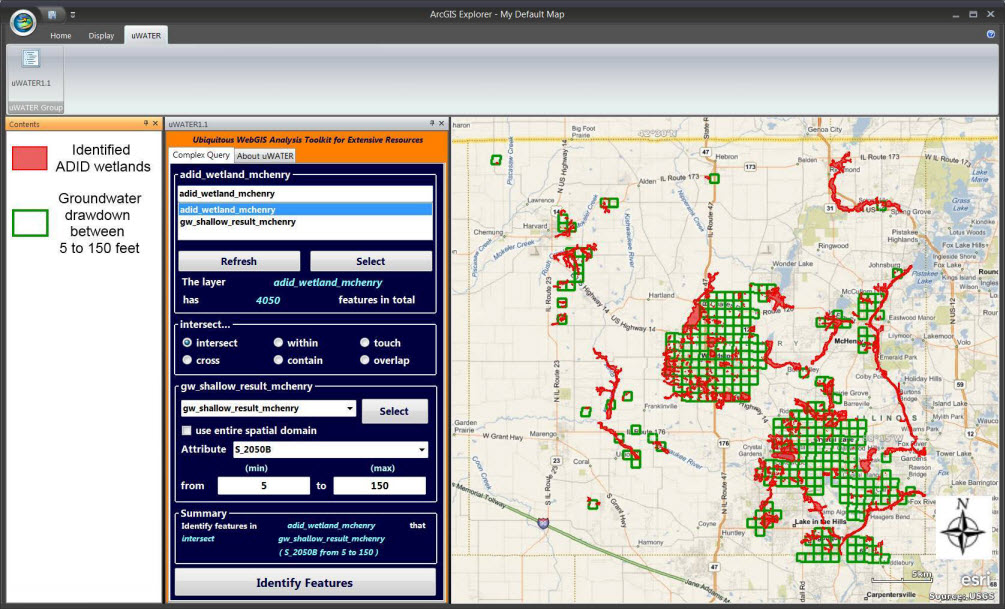Hydro scientists like us are commonly asked questions by policy makers and stakeholders like: “how do I know if this new well or new canal will affect the surrounding area?” or “Are my wells going to dry out because my neighbor built a new one?” One of the major challenges in GIScience to address these questions is to develop a tool that can translate the scientific understanding into easily understood, evidence-based policy or decision. We present plug-ins that work with ArcGIS Explorer Desktop (AGX): the ubiquitous WebGIS Analysis Toolkit for Extensive Resources (uWATER), and its extension: uWATER-Pumping Assessment (uWATER-PA) to accomplish these tasks. The uWATER package provides quick answers by visualizing the alternative developments for natural resource management in intuitive and simple approaches. We follow with a few examples of how policy makers can implement the uWATER package.
Using uWATER to identify the most vulnerable wetlands due to groundwater pumping
To find the vulnerable wetlands using uWATER, first, load the wetlands and modeled groundwater drawdown shapefiles into AGX. Then click the Refresh button on the uWATER interface, to display in the listbox all loaded shapefiles. Move the cursor to highlight the wetland shapefile, and then click the Select button to display some basic information about the selected shapefile in the uWATER interface. Use the radio buttons on the uWATER interface to select the spatial relationship for the query. Then select and employ for query criteria a second layer (the groundwater drawdown shapefile) from the dropdown list in order to enable the selection of alternative drawdown conditions (in this case, S_2050B representing drawdown at 2050 under a normal pumping scenario) for policy making. Finally, specify minimum and maximum attribute values (the range of drawdown) to employ in the query. Click the Identify Features button to show the final results.

The cells outlined in green denote areas having predicted drawdown between 5 and 150 feet by a numerical model. uWATER identifies in red the wetlands intersecting the green-outlined cells; these wetlands are the most vulnerable wetlands to the predicted groundwater drawdown in 2050.
Using uWATER-PA to evaluate the effect of a new pumping well on existing wells
The second example we’ll discuss shows how uWATER-PA can help a stakeholder evaluate the impact of a new pumping well. The figure below shows the “Data Input” tab on uWATER-PA interface. First, specify the computing unit, then, click on the “Add a well on the map using the cursor” button and add a new well with one click on the map area. Next, choose the desired impact radius and then import the preloaded hydrogeological parameters (i.e. transmissivity and storativity) and existing well shapefile from AGX.

Next, use the “Impact Assessment” tab to input some simple configurations of the new well: maximum and actual pumping rate and duration. After clicking the compute impact buttons, the uWATER-PA will evaluate the maximal and/or actual impact of the new well and the impacted area and existed wells using color coding adapted from the Homeland Security Advisory System.


An example result of uWATER-PA is shown in the following figure. The stakeholder can see the impact range on the map and by clicking the resulted cells or wells, the actual impact (approximate additional drawdown) will show in the pop-up window.

The uWATER packages (programs, example files, and users’ manuals) are free to download at http://www.isws.illinois.edu/gws/sware/.
Special thanks to Drs. Yu-Feng Forrest Lin and Yi-Chen Ethan Yang for contributing this post. Questions for Dr. Lin: yflin@illinois.edu. Questions for Dr. Yang: yceyang@engin.umass.edu

Article Discussion: